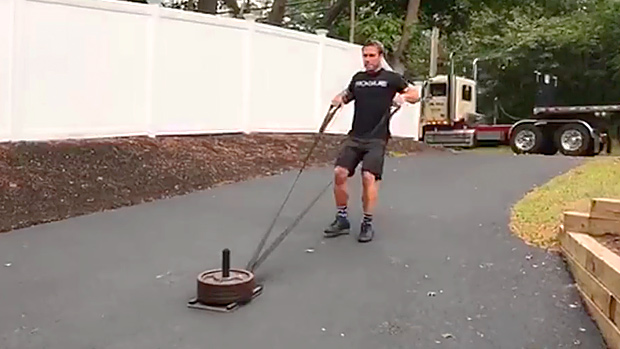I may not be your average, creepy magician, able to pull scared shitless rabbits out of my hat, but I did reach into my gym bag for not just one, but six random training tips.
Most of these I learned from just getting under the bar, wrapping my hands around the knurling, and squeezing like hell. Some are heavily backed by science, some haven't even been studied, and others go against the current research, leaving our friends in lab coats standing out in the cold with their pants around their ankles.
To make it on this list, science is only a guiding light; the only validity indicator is whether or not it works in the real world.
1. Slow Down for Thick Arms
If you want a thick upper arm (and who doesn't?), slower tempo biceps work is a must, especially when done with a hammer grip.
This is because the often neglected brachialis (the muscle that's somewhat underneath the biceps) has been shown to respond best to slower tempos and isometric actions.

The moral of the story is that if you want to maximize arm growth, both slow and fast tempos must be used.
2. Refine Your Leg Recruitment
When doing standing leg work and leg presses, pushing with your heels (even raising your toes up to avoid pushing with them) will recruit the glutes and hamstrings to a greater extent. If you push with your toes, you'll get more quad activation.
This is one of the reasons why Olympic lifters have such great quads. Their shoes have an elevated heal that's anywhere from half an inch to one and a half inches, which is kind of like squatting with your heels on a five or ten-pound plate. This elevation shifts the effort more toward the front of the foot, which leads to freakish quad development.
For that reason, if your goal is straight muscle, squatting with elevated heels is fine, provided that you rotate it with flat-heel squatting to avoid developing a muscle imbalance.
3. Outsmart the Adaptation Process
Recovering from exercise requires energy, as well as a myriad of nutrients. This goes beyond the simple act of restoring the energy used during the workout. The multiple processes involved in repairing muscle damage, reloading energy stores, getting the CNS back to optimal functioning, and then improving all of these systems requires a lot of energy.
The more perturbing a training session was for your body, the harder the recovery and adaption process will be. The harder this process is, the more energy you'll need to fuel it.
When you constantly train the same way, your body becomes efficient at tolerating and adapting to this type of work, and as a result it costs less energy to adapt.
So, if fat loss is your main objective, it's important to use a variety of training types to increase the need for adaptation.
Start by including many things from this list:
Heavy lifting
High density (very short rest periods, higher reps) lifting aimed at increasing lactate production
Intervals (if your diet is good)
Low-intensity cardio
Playing various sports
Walking
Jumps and throws
Sprints
Relaxation exercises
4. Think You're Ready? Jump!
One of the best and easiest ways to see if your nervous system is primed for a top-notch performance is to perform a vertical jump prior to every workout.
Start by testing yourself in a normal, well-rested state, ideally three to five days after CNS-intensive training. This will be your base value.
Test yourself prior to every workout, and if your test goes up two or more inches all of a sudden, your CNS is ready to rock. This day is a good time to include a lot of heavy lifting (even going for a one or three-rep max) or explosive training.
If your test goes down two to four inches, then it's best to lower the amount of CNS-intensive training, opting for less draining methods.
If your test goes down more than four inches, go home and forget about the gym for a few days.
If your test score is within one or two inches of your regular score, proceed with your regular workout.
Obviously, this simple test doesn't take into account that your training might lead to increases in your vertical jump. However, if you add four to eight inches to your vertical over an eight-week period, that still represents an average gain of only half an inch to one inch per week, which will allow you to adjust your base value.
For example, let's pretend your initial test is 31 inches and your progression looks like this:
Week 1
Workout 1: 31 inches
Workout 2: 30 inches
Workout 3: 32 inches
Workout 4: 32 inches
Week 2
Workout 1: 32 inches
Workout 2: 31 inches
Workout 3: 32 inches
Workout 4: 32 inches
By that time, it's safe to say that your new base value should be 32 inches instead of 31. From that point on, you can go for a super-intense session if you reach 34 inches.
And while this test is fine and dandy, it's pretty much worthless if you did a hard leg session the day before and it feels like someone beat your legs with a tube sock full of quarters. Muscle fatigue, more so than neural fatigue, might decrease your jumping performance.
So, is there another test to use? Hell yes! Using a hand-held dynamometer, test your grip strength prior to every workout.
If your grip strength goes up by more than 10% all of a sudden, this is your day to go heavy or lift explosively.
If it goes down 10 to 15%, lower the amount of CNS-intensive training.
Lastly, if it goes down more than 15%, well, you know what to do – take some rest!
5. Maximize Your Growth Capacity
The more you can train without exceeding your capacity to recover, the more you'll progress.
Now, before you start doing 100 sets for your biceps, don't forget the "without exceeding your capacity to recover" bit!
To maximize your capacity to train and grow, there are several things you can do:
• Include recovery methods within your training plan. Sport massages, contrast showers, Epsom salt baths, and acupuncture (when performed by a good provider) can help you increase your capacity to tolerate and adapt to training stress.
• Gradually increase your work capacity by adding conditioning work to your training plan. This could include low-intensity sled dragging, low to moderate-intensity energy systems work, or very short (20 minutes or so) mini-training sessions of very high rep work (Soviet athletes used up to 200 reps per set from time to time!).
• Alkalize your diet. When your body is acidic, all of the positive metabolic processes slow to a crawl. Thus, being acidic will lead to a slower rate of recovery and you'll have a harder time building muscle, as well as losing fat. Protein is acid-forming, so those of us here at Testosterone are particularly at risk of becoming acidic. To counter this, every time you eat protein, make sure to ingest one of the following acid-lowering items: veggies, Superfood, fruits, almonds, or glutamine.
• Use recovery-enhancing supplements. Surge® Recovery is a must to maximize immediate recovery from training. Power Drive®,when taken after a training session, will help with neural recovery by enhancing blood flow to the brain and neurotransmitters production. Rhodiola rosea acts as an adaptogen, increasing the body's general capacity to tolerate and adapt to stress.
Glycine at three to five grams per afternoon meal and five to ten grams before bed (if you can tolerate it) will lower cortisol levels and help you sleep. Phosphatidylserine at 300 to 400 mg post-workout will help lower cortisol levels, which will tip the scale toward anabolism. It can also be added in the evening with glycine to lower cortisol even more (cortisol should be higher in the morning and lower in the evening).
6. Mass without Movement
The impact of isometrics (exerting force with a muscle without any movement) on maximal strength is well documented and undeniable. Among other things, it's a great method to strengthen a weak point in your range of motion.
However, the use of isometrics to build muscle isn't as popular, and the research is rather sparse, often indicating no benefits.
But, isometrics, when properly used, can build muscle mass and increase muscle density.
So, why is it believed that isometrics can't build muscle?
A) Because strength gains come quicker and are easier to measure objectively than muscle growth.
Most scientific studies last anywhere from four to 12 weeks (12 weekers are rather rare in exercise science). Significant strength gains can occur within one to two weeks due to neural adaptations. But how much muscle tissue can you build in that time frame?
On an optimal program, you might be able to gain a pound or so. But that increase would be over your whole body and studies often only test and measure one muscle group. Even if you were to gain three pounds of muscle over a four-week study, if they only measure the amount of muscle gained in the biceps, it'll be what, a few grams.
Not to mention that these studies rarely utilize a complete training program. That alone severely limits any potential muscle growth.
Under these shoddy circumstances, it'll be hard to gain enough mass in the tested muscle group to reach statistical significance.
B) Because scientific studies utilize a suboptimal isometric approach.
More often than not, they'll use the original protocol of doing a single daily isometric contraction lasting around six seconds (this is the one that showed strength gains in the initial work of Hettinger and Muller).
Modern research has evolved in terms of volume, but generally sticks to the six to nine second range.
The six to nine second range is the equivalent, time under tension-wise, of doing a regular set of an exercise for two to four reps. Good for strength, but far from ideal for size.
To be effective for stimulating growth, isometrics would have to be performed for a longer time under tension.
C) Because of the lack of muscle micro-trauma.
It's well documented that most muscle damage occurs during the eccentric portion of an exercise. Isometric work, on the other hand, doesn't inflict a significant amount of damage. Since this trauma is often believed to be the stimulus for muscle growth, it's easy to assume that a method that doesn't inflict damage won't lead to growth.
The fact is that there's more than one way to grow. Muscle damage is obviously one, but we must also include the increase in local growth factors such as IGF and its variants, as well as growth hormone.
Studies have shown that even very light training performed under a situation where blood flow to the muscle is restricted will stimulate muscle growth. The main reason is that the hypoxia (lack of oxygen) that occurs within the muscle leads to an increase in local growth factors within the trained muscle.
How does this relate to isometrics? Well, when a muscle is fully contracted, blood flow into that same muscle is highly restricted because of capillary constriction. It's when the muscle relaxes (either after a set or between reps) that blood entry is resumed.
So, with an isometric action, you can cause a state of hypoxia, which will lead to an increase in growth factors. The thing is that if the length of the contraction is short (six to nine seconds) it won't deprive the muscle of oxygen for long enough to stimulate the release of growth factors. To do so, the length of the contraction needs to be around 20 to 40 seconds.
So, what exactly are the effective ways of stimulating growth with isometrics?
Well, first understand the various forms of isometrics. With all these methods, the external result is the same: the muscle is contracted, but there's no movement. But each of them has a different internal effect, which will lead to different results.
Yielding isometrics: This refers to an action where you try to prevent a load from falling. For example, holding a barbell at the mid-point of a curl, or trying to prevent it from moving down.
Overcoming isometrics: This refers to an action where you try to lift an immovable load. Say, pushing as hard as you can against a set of safety pins in the power rack.
There are other types of isometrics, such as functional isometrics and isometric-dynamic contrasts, but these are combination methods and will be discussed more in a few minutes.
For now, understand the difference between overcoming and yielding isometrics.
Due to their nature, yielding isometrics have a motor activation pattern that's closer to the eccentric (lowering) portion of a lift, and as a big plus, activate more fast-twitch muscle fibers.
Overcoming isometrics are closer in their activation pattern to the concentric portion of a lift.
For these reasons, overcoming isometrics are best suited to increase strength and should be used for shorter sets in the six to 12-second range, while yielding isometrics are better at stimulating muscle growth and are best performed for longer sets of 20 to 40 seconds.
If you want to utilize the isometric method to increase muscle growth, these are your best choices:
A) Yielding isometrics performed by themselves for sets of 20 to 40 seconds.
B) Yielding isometrics as a post-fatigue exercise in a superset. For example, perform six to eight reps of a lying cable curl followed by a 20-second hold on the preacher curl.
C) Yielding isometrics at the end of a regular set. For example, perform six to eight reps on the preacher curl, and when you reach failure, hold the bar at the mid-point for as long as you can.
D) Lastly, with iso-dynamic contrasts, you hold the weight for a certain period of time on each rep. For example, perform a lat pull-down and hold the peak contraction for five seconds on each rep. Or perform a back squat, holding a five-second contraction when the knees are at 90 degrees.
Isometrics can't completely replace good ole lifting. But as an adjunct to it, they're a nice sparkplug if you've been stalled for some time.
Go Forth and Grow
It's time to strategically employ some of today's randomness into your growth plan.
By the way, got a subject you'd like to see me tackle for an upcoming Monday? Make your voice heard!





